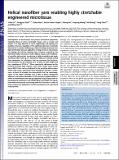| dc.contributor.author | Li, Yiwei | |
| dc.contributor.author | Hao, Yukun | |
| dc.contributor.author | Gupta, Satish Kumar | |
| dc.contributor.author | Hu, Jiliang | |
| dc.contributor.author | Wang, Yaqiong | |
| dc.contributor.author | Guo, Ming | |
| dc.date.accessioned | 2020-03-30T19:21:09Z | |
| dc.date.available | 2020-03-30T19:21:09Z | |
| dc.date.issued | 2019-04-24 | |
| dc.identifier.issn | 0027-8424 | |
| dc.identifier.issn | 1091-6490 | |
| dc.identifier.uri | https://hdl.handle.net/1721.1/124421 | |
| dc.description.abstract | Development of microtissues that possess mechanical properties mimicking those of native stretchable tissues, such as muscle and tendon, is in high demand for tissue engineering and regenerative medicine. However, regardless of the significant advances in synthetic biomaterials, it remains challenging to fabricate living microtissue with high stretchability because application of large strains to microtissues can damage the cells by rupturing their structures. Inspired by the hierarchical helical structure of native fibrous tissues and its behavior of nonaffine deformation, we develop a highly stretchable and tough microtissue fiber made up of a hierarchical helix yarn scaffold, scaling from nanometers to millimeters, that can overcome this limitation. This microtissue can be stretched up to 15 times its initial length and has a toughness of 57 GJ m−3. More importantly, cells grown on this scaffold maintain high viability, even under severe cyclic strains (up to 600%) that can be attributed to the nonaffine deformation under large strains, mimicking native biopolymer scaffolds. Furthermore, as proof of principle, we demonstrate that the nanotopography of the helical nanofiber yarn is able to induce cytoskeletal alignment and nuclear elongation, which promote myogenic differentiation of mesenchymal stem cells by triggering nuclear translocation of transcriptional coactivator with PDZ-binding motif (TAZ). The highly stretchable microtissues we develop here will facilitate a variety of tissue engineering applications and the development of engineered living systems. | en_US |
| dc.language.iso | en | |
| dc.publisher | Proceedings of the National Academy of Sciences | en_US |
| dc.relation.isversionof | 10.1073/pnas.1821617116 | en_US |
| dc.rights | Article is made available in accordance with the publisher's policy and may be subject to US copyright law. Please refer to the publisher's site for terms of use. | en_US |
| dc.source | PNAS | en_US |
| dc.subject | Multidisciplinary | en_US |
| dc.title | Helical nanofiber yarn enabling highly stretchable engineered microtissue | en_US |
| dc.type | Article | en_US |
| dc.identifier.citation | Li, Yiwei et al. "Helical nanofiber yarn enabling highly stretchable engineered microtissue." Proceedings of the National Academy of Sciences of the United States of America 116 (2019):9245-9250 © 2019 The Author(s) | en_US |
| dc.contributor.department | Massachusetts Institute of Technology. Department of Mechanical Engineering | |
| dc.relation.journal | Proceedings of the National Academy of Sciences of the United States of America | en_US |
| dc.eprint.version | Final published version | en_US |
| dc.type.uri | http://purl.org/eprint/type/JournalArticle | en_US |
| eprint.status | http://purl.org/eprint/status/PeerReviewed | en_US |
| dc.date.updated | 2020-02-12T18:41:03Z | |
| dspace.date.submission | 2020-02-12T18:41:05Z | |
| mit.journal.volume | 116 | en_US |
| mit.journal.issue | 19 | en_US |
| mit.metadata.status | Complete | |
